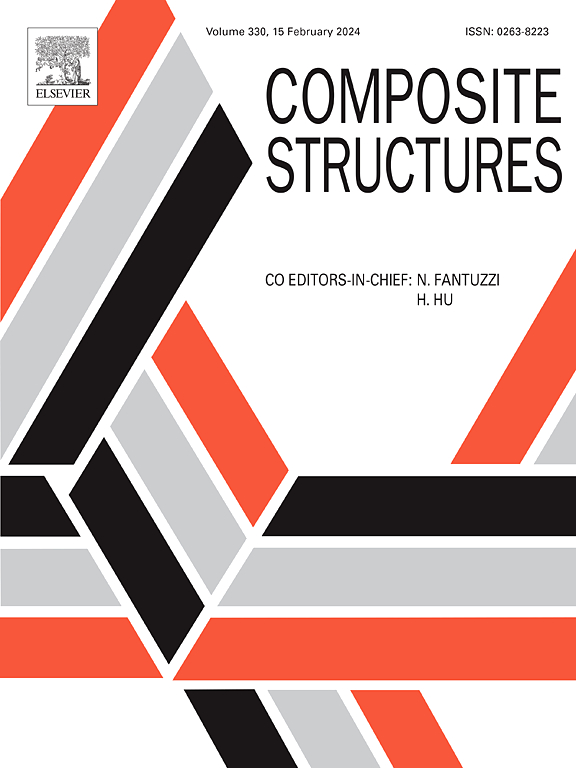一维和二维排列钢纤维增强水泥基复合材料的压缩性能
IF 7.1
2区 材料科学
Q1 MATERIALS SCIENCE, COMPOSITES
引用次数: 0
摘要
钢纤维增强水泥基复合材料的抗压性能受纤维取向的影响较大。本研究基于电磁场处理制备了单向和二维排列钢纤维水泥基复合材料(1D-ASFRC和2D-ASFRC)试样,并进行了立方压缩和棱镜单轴压缩试验。结果表明:与随机分布的钢纤维增强水泥基复合材料(SFRC)相比,1D-ASFRC和2D-ASFRC的立方抗压强度分别提高了9.4%和15.7%;2D-ASFRC和1D-ASFRC的单轴抗压强度分别提高了4%和8.9%以上。此外,1D-ASFRC和2D-ASFRC的压缩吸收能量和压缩韧性比也呈增加趋势。提出了纤维取向影响系数来表征纤维取向对单轴压缩性能的贡献,建立了SFRC、1D-ASFRC和2D-ASFRC的应力-应变本构模型。2D-ASFRC的破坏模式与SFRC不同。SFRC和1D-ASFRC试件均表现出典型的斜剪破坏模式,2D-ASFRC试件具有多条不连续窄裂纹,且无贯通裂纹,抗压韧性得到改善。从纤维分布上揭示了钢纤维一维和二维排列的增强机理。本文章由计算机程序翻译,如有差异,请以英文原文为准。
Compression behavior of 1D and 2D aligned steel fiber reinforced cement-based composites
The compressive performance of steel fiber reinforced cement-based composites is highly affected by fiber orientation. In this study, specimens of cement-based composites with unidirectionally and two-dimensionally aligned steel fibers (1D-ASFRC and 2D-ASFRC) were manufactured based on electromagnetic field treatment, and the cubic compressive and prism uniaxial compressive test were conducted. The results showed that compared with randomly distributed steel fiber reinforced cement-based composites (SFRC), the cubic compressive strength of 1D-ASFRC and 2D-ASFRC was increased up to 9.4 % and 15.7 %, respectively. The uniaxial compressive strength of 2D-ASFRC and 1D-ASFRC rose by over 4 % and 8.9 %. Additionally, compression absorbed energy and compression toughness ratio were also observed an increasing trend for 1D-ASFRC and 2D-ASFRC. The fiber orientation influence coefficient was proposed to characterize the contribution of fiber orientation on the uniaxial compressive behavior, and the stress–strain constitutive models of SFRC, 1D-ASFRC and 2D-ASFRC were established. The failure patterns of 2D-ASFRC were found to be different from that of SFRC. A typical oblique shear failure mode can be observed in SFRC and 1D-ASFRC specimens, while 2D-ASFRC demonstrated the improved compression toughness with multiple discontinuous narrow cracks and without penetrating cracks. The reinforcement mechanism of 1D- and 2D- aligned steel fibers was revealed from fiber distribution.
求助全文
通过发布文献求助,成功后即可免费获取论文全文。
去求助
来源期刊

Composite Structures
工程技术-材料科学:复合
CiteScore
12.00
自引率
12.70%
发文量
1246
审稿时长
78 days
期刊介绍:
The past few decades have seen outstanding advances in the use of composite materials in structural applications. There can be little doubt that, within engineering circles, composites have revolutionised traditional design concepts and made possible an unparalleled range of new and exciting possibilities as viable materials for construction. Composite Structures, an International Journal, disseminates knowledge between users, manufacturers, designers and researchers involved in structures or structural components manufactured using composite materials.
The journal publishes papers which contribute to knowledge in the use of composite materials in engineering structures. Papers deal with design, research and development studies, experimental investigations, theoretical analysis and fabrication techniques relevant to the application of composites in load-bearing components for assemblies, ranging from individual components such as plates and shells to complete composite structures.
 求助内容:
求助内容: 应助结果提醒方式:
应助结果提醒方式:


